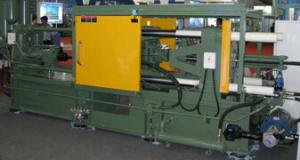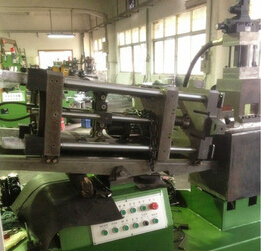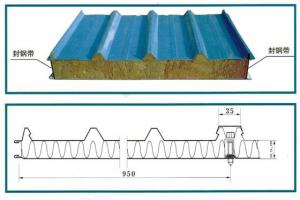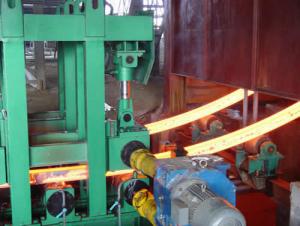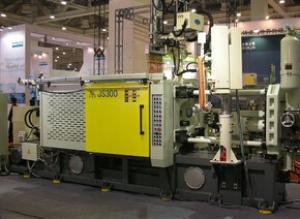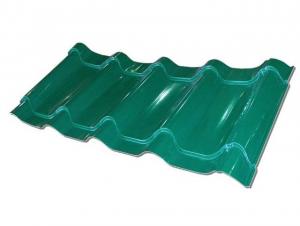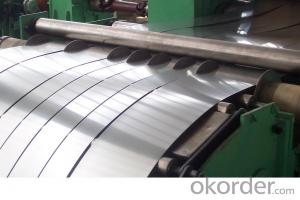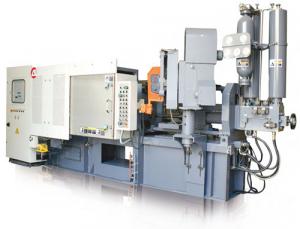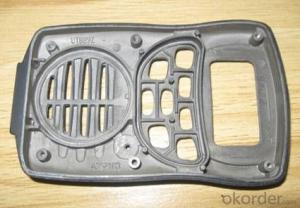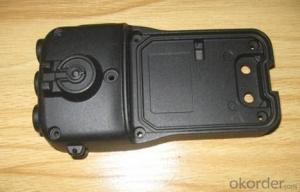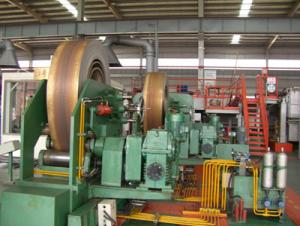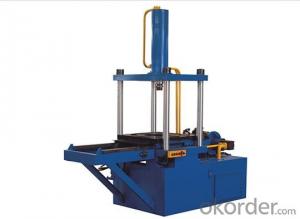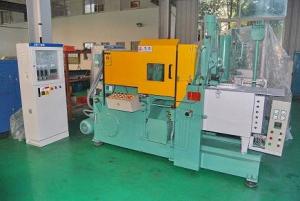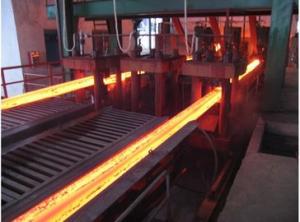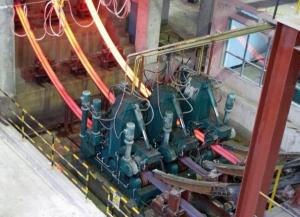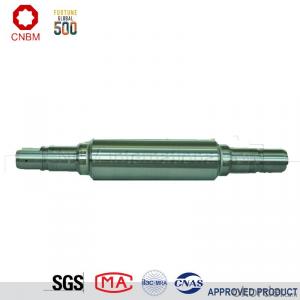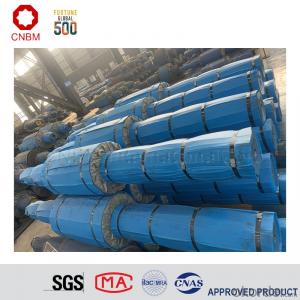Aluminum Pressure Die Casting Machine
OKorder Service Pledge
Quality Product, Order Online Tracking, Timely Delivery
OKorder Financial Service
Credit Rating, Credit Services, Credit Purchasing
You Might Also Like
KS Series High-equipped Die Casting Machine
Specifications
1.Competitive price and high quality,
2.More convenient and safety
3.High shot speed
4.Shorter pressure setting up time
- Q: What are the different types of finishes applied to castings using metal casting machinery?
- By utilizing metal casting machinery, various finishes can be applied to castings. These finishes serve to augment the casting's appearance, enhance its surface quality, and safeguard it from corrosion. Some commonly employed finishes for castings include: 1. Achieving a machined finish: This entails utilizing precise machining techniques to eliminate excess material and create a smooth and consistent surface finish. It is commonly employed for critical components that necessitate tight tolerances and meticulous precision. 2. Employing a sandblasted finish: This process involves directing a high-pressure stream of sand or other abrasive materials at the casting surface to eliminate impurities, oxides, or roughness. Sandblasting produces a textured surface that is visually appealing and facilitates better adhesion for subsequent coatings. 3. Utilizing a powder coat finish: This finish involves electrostatically spraying a dry powder paint onto the casting, followed by curing in an oven. It results in a durable and uniform coating that is resistant to chipping, scratching, and fading. Powder coating offers a wide array of colors and finishes, making it suitable for both decorative and functional applications. 4. Employing an anodized finish: This process utilizes chemicals to create a protective oxide layer on the casting's surface. Anodizing enhances the casting's corrosion resistance and durability, while also providing an attractive finish. It is commonly employed for aluminum castings in industries such as aerospace and automotive. 5. Utilizing a polished finish: Polishing involves the use of abrasive materials, such as polishing wheels or compounds, to eliminate imperfections and create a smooth and reflective surface. This finish is often employed for decorative castings that necessitate a high level of shine and luster. 6. Employing a plated finish: Plating involves depositing a thin layer of metal onto the casting surface through electroplating or electroless plating processes. Plated finishes offer enhanced corrosion resistance, improved appearance, and can also be utilized to impart specific functional properties, such as increased hardness or conductivity. These examples merely scratch the surface of the various finishes that can be applied to castings using metal casting machinery. The choice of finish depends on factors such as desired appearance, functionality, and the environmental conditions to which the casting will be exposed.
- Q: How is the casting inspected for quality control in metal casting machinery?
- To ensure the final product meets the desired specifications, the quality control process for inspecting casting in metal casting machinery entails several steps. Firstly, trained inspectors visually examine each casting to identify any visible defects such as cracks, surface roughness, or porosity. They meticulously scrutinize each casting to ensure no irregularities go unnoticed. In addition, non-destructive testing techniques are commonly utilized to evaluate the internal quality of the casting. X-ray or radiographic testing allows for a comprehensive examination of the casting's internal structure, unveiling any hidden defects, inclusions, or material inconsistencies. Ultrasonic testing is another technique employed for quality control. By utilizing high-frequency sound waves, flaws or discontinuities within the casting can be detected. This method effectively identifies issues like voids, gas pockets, or inclusions that have the potential to compromise the casting's integrity. Furthermore, the dimensional accuracy of the casting is thoroughly inspected using precise measuring tools such as calipers, micrometers, or coordinate measuring machines (CMMs). These instruments guarantee that the casting adheres to the required tolerances and dimensions specified in the design. Chemical analysis and mechanical testing are also indispensable in quality control. Chemical analysis determines the composition of the metal used in the casting, ensuring it aligns with the required specifications. Meanwhile, mechanical testing involves subjecting the casting to various stress and load conditions to evaluate its strength, durability, and resistance to deformation. In summary, the inspection of casting in metal casting machinery adopts a comprehensive approach that encompasses visual examination, non-destructive testing, dimensional inspection, chemical analysis, and mechanical testing. This meticulous multi-step process ensures that the casting meets the desired quality standards and is suitable for its intended application.
- Q: What industries commonly use metal casting machinery?
- Metal casting machinery is commonly used in a variety of industries that require the production of metal components or products. One of the primary industries that heavily relies on metal casting machinery is the automotive industry. Metal casting is essential in the manufacturing of engine parts, transmission parts, and other critical components used in automobiles. The machinery is used to cast engine blocks, cylinder heads, pistons, and various other metal parts required for the assembly of vehicles. Similarly, the aerospace industry also extensively employs metal casting machinery. It is used to manufacture components like turbine blades, jet engine parts, and structural components for aircraft. The machinery allows for the production of intricate and precisely shaped metal parts that meet the stringent requirements of the industry. The construction industry is another sector that commonly utilizes metal casting machinery. It is used to cast components like pipes, fittings, valves, and other structural elements required for buildings and infrastructure projects. The machinery enables the production of high-quality and durable metal components that can withstand the demands of the construction industry. The energy sector, including oil and gas, also relies on metal casting machinery. It is used to produce various components used in power generation systems, such as turbine components, pump housings, and valves. The machinery allows for the casting of complex shapes and designs that can withstand the harsh operating conditions in the energy industry. Additionally, the manufacturing industry as a whole utilizes metal casting machinery for the production of a wide range of products. This includes consumer goods like kitchen appliances, tools, and machinery parts. Metal casting machinery enables manufacturers to produce large quantities of metal components quickly and cost-effectively. In conclusion, several industries commonly use metal casting machinery, including automotive, aerospace, construction, energy, and manufacturing. The machinery plays a vital role in producing high-quality metal parts and components required for various applications in these industries.
- Q: How does metal casting machinery handle the removal of casting defects?
- Metal casting machinery handles the removal of casting defects through various methods such as cutting, grinding, or sandblasting. These machines are equipped with specialized tools and techniques that help in removing any imperfections or unwanted elements from the castings, ensuring a high-quality end product.
- Q: What are the cost-saving measures for metal casting machinery?
- There are numerous ways to achieve cost savings in metal casting machinery. Here are some effective strategies: 1. Efficient energy utilization: Energy consumption is a significant expense in metal casting machinery. To save costs, it is crucial to ensure the machinery operates efficiently and employs energy-saving techniques. This includes using energy-efficient motors and implementing proper insulation. 2. Process enhancement: Analyzing the metal casting process is essential for cost savings. Identifying areas that require improvement, such as optimizing casting cycle time, reducing material waste, and minimizing rework or scrap, can result in substantial savings in both material and labor costs. 3. Regular maintenance and equipment upgrades: Regular maintenance is vital to prevent breakdowns and minimize downtime. By investing in preventive maintenance, manufacturers can avoid costly repairs and prolong the machinery's lifespan. Additionally, upgrading outdated equipment with newer, more efficient models can reduce operating costs and enhance productivity. 4. Automation and robotics: The integration of automation and robotics can reduce labor costs and improve efficiency in metal casting processes. Automated systems can perform repetitive tasks accurately and quickly, minimizing the need for manual labor and reducing the risk of human errors. Investing in robotic solutions can lead to significant long-term cost savings. 5. Material selection and recycling: Careful selection of materials for metal casting can have a substantial impact on cost savings. Opting for lower-cost alloys or utilizing recycled materials can reduce raw material expenses without compromising quality. Furthermore, implementing recycling programs for scrap metal generated during the casting process can provide additional cost-saving opportunities. 6. Effective supply chain management: Efficient supply chain management is crucial for cost savings in metal casting machinery. Negotiating favorable contracts with suppliers, optimizing inventory levels, and minimizing transportation costs can all contribute to reducing overall production expenses. By implementing these cost-saving strategies, manufacturers can optimize their metal casting machinery operations, decrease expenses, and enhance long-term profitability.
- Q: How do you design and create cores for metal casting machinery?
- Designing and creating cores for metal casting machinery involves a systematic process that requires careful planning and attention to detail. Here are the key steps involved in this process: 1. Understand the casting requirements: The first step is to thoroughly understand the casting requirements, including the shape, size, and complexity of the final metal part to be cast. This understanding will help determine the type of core needed and its design considerations. 2. Select core materials: Cores can be made from a variety of materials, such as sand, ceramic, or metal. The selection of core material depends on factors like the metal being cast, the desired surface finish, and the complexity of the part. Each material has its own advantages and limitations, so choosing the most suitable material is crucial. 3. Design the core geometry: Based on the casting requirements, the core geometry needs to be designed. This includes determining the shape, size, and location of the core within the mold cavity. Computer-aided design (CAD) software can be used to create the 3D model of the core, ensuring precision and accuracy. 4. Consider core assembly: In some cases, multiple cores are needed to create complex metal parts. The assembly of these cores must be carefully planned to ensure proper fit and alignment. The design should also consider the ability to remove the cores from the casting once it is solidified. 5. Determine core placement and gating system: The cores need to be strategically placed within the mold cavity to facilitate proper metal flow and minimize defects. The gating system, which includes channels and gates, should be designed to allow molten metal to flow smoothly around the cores. 6. Create the core: Once the design is finalized, the core can be manufactured. This process may involve various techniques such as sand core making, where sand is mixed with a binder and shaped to form the core, or ceramic core manufacturing, where a ceramic slurry is poured into a mold and then fired to create a solid core. Metal cores can be fabricated using various metalworking techniques like machining or additive manufacturing. 7. Test and refine: After the core is created, it is essential to test its fit, stability, and effectiveness. This may involve conducting simulations or physical tests to identify any issues or defects. Based on the test results, modifications can be made to the core design if necessary. By following these steps, engineers and designers can effectively design and create cores for metal casting machinery, ensuring the production of high-quality metal parts with accurate shapes and dimensions.
- Q: How are the molds prepared for sand casting in metal casting machinery?
- In metal casting machinery, the molds are prepared for sand casting through a series of steps. Firstly, a pattern is created which is a replica of the desired metal part. The pattern is typically made from wood, metal, or plastic and is slightly larger than the final part size to account for shrinkage during the casting process. Once the pattern is ready, a flask is prepared. A flask consists of two parts, the cope (top) and the drag (bottom), which are boxes that hold the sand and form the mold cavity. The flask is positioned with the cope on top and the drag on the bottom. Next, a release agent is applied to the pattern and inside the flask to prevent the sand from sticking. This can be a spray or a powder substance. After applying the release agent, the pattern is placed in the drag and sand is added around it. The sand used is typically a mixture of silica sand and a binder, which helps the sand hold its shape. The sand is compacted around the pattern using a ramming tool or by vibrating the flask to ensure that all contours of the pattern are captured. Once the drag is filled with sand, the cope is placed on top and more sand is added to fill the flask completely. The sand is then again compacted and leveled to create a smooth surface. To create the mold cavity, the cope and drag are separated and the pattern is removed. This leaves a hollow space in the shape of the desired metal part within the sand. To further reinforce the mold, additional components such as cores or chaplets may be added. Cores are pre-formed sand shapes that create internal cavities in the final casting, while chaplets are metal pins used to support the cores. Finally, the cope and drag are aligned and securely clamped together to ensure that the mold maintains its shape during the casting process. Overall, the preparation of molds for sand casting in metal casting machinery involves the creation of a pattern, the assembly of the flask, the application of a release agent, the filling and compacting of sand, the removal of the pattern, and the addition of any necessary components. These steps are crucial in creating a high-quality mold that can produce an accurate and defect-free metal casting.
- Q: What are the ergonomic considerations for operating metal casting machinery?
- The ergonomic considerations for operating metal casting machinery include ensuring proper workstation layout and design to minimize physical strain and promote comfortable body posture, providing adjustable controls and handles to accommodate operators of different heights and body sizes, implementing vibration isolation measures to reduce the risk of injuries caused by excessive machine vibrations, incorporating appropriate lighting to prevent eye strain and enhance visibility, and offering training programs to educate operators on safe work practices and techniques for lifting heavy objects. Additionally, regular maintenance and inspections of the machinery are necessary to identify and address any potential ergonomic hazards.
- Q: What are the different types of molding sands used in metal casting machinery?
- There are several different types of molding sands used in metal casting machinery, each with its own unique properties and applications. 1. Green Sand: Green sand is the most commonly used molding sand in metal casting. It is a mixture of silica sand, clay, water, and additives like coal dust or wood flour. Green sand is affordable, readily available, and easy to work with. It can be reused multiple times by reconditioning or reprocessing. 2. Dry Sand: Dry sand, as the name suggests, does not contain any moisture. It is made by mixing silica sand with a binder, like clay or resin, and is used for high-quality castings that require precise dimensions and a smooth surface finish. Dry sand molds are more stable and have better dimensional accuracy than green sand molds. 3. Loam Sand: Loam sand is a mixture of sand, clay, and organic materials like straw or horse dung. It is typically used for large and irregularly shaped castings. Loam sand molds are highly flexible and can withstand the weight of molten metal without deforming. 4. Facing Sand: Facing sand is a fine-grained sand used on the face of the mold cavity to give a smooth and clean surface finish to the casting. It is usually made from high-quality silica sand and is mixed with clay or other binders to improve its strength and adhesion. 5. Backing Sand: Backing sand, also known as floor sand, is used to support the facing sand and provide strength to the mold cavity. It is coarser in texture and contains larger grains compared to facing sand. Backing sand is usually made from silica sand mixed with clay and other additives for improved strength and permeability. 6. Core Sand: Core sand is used to create internal cavities or cores within the mold. These cores provide the required shape and structure to the casting. Core sand is typically made from silica sand mixed with a binder, like resin or oil, to give it the necessary strength and stability. 7. Oil Sand: Oil sand is a type of core sand that is mixed with oil instead of water. It is used for making large and complex castings that require high precision and dimensional accuracy. Oil sand cores have good strength, excellent dimensional stability, and can be easily removed from the casting without any damage. Each type of molding sand has its own advantages and limitations, and the choice of sand depends on factors such as the size, complexity, and desired surface finish of the casting, as well as the metal being cast and the production requirements.
- Q: How does metal casting machinery handle the finishing operations of castings?
- Metal casting machinery handles the finishing operations of castings through various processes such as grinding, sanding, polishing, and deburring. These machines are equipped with specialized tools and attachments that remove any excess material, smooth out rough surfaces, and enhance the overall appearance of the castings. The machinery ensures precise and consistent finishing, improving the quality and functionality of the castings before they are ready for use.
Send your message to us
Aluminum Pressure Die Casting Machine
OKorder Service Pledge
Quality Product, Order Online Tracking, Timely Delivery
OKorder Financial Service
Credit Rating, Credit Services, Credit Purchasing
Similar products
Hot products
Hot Searches
Related keywords


